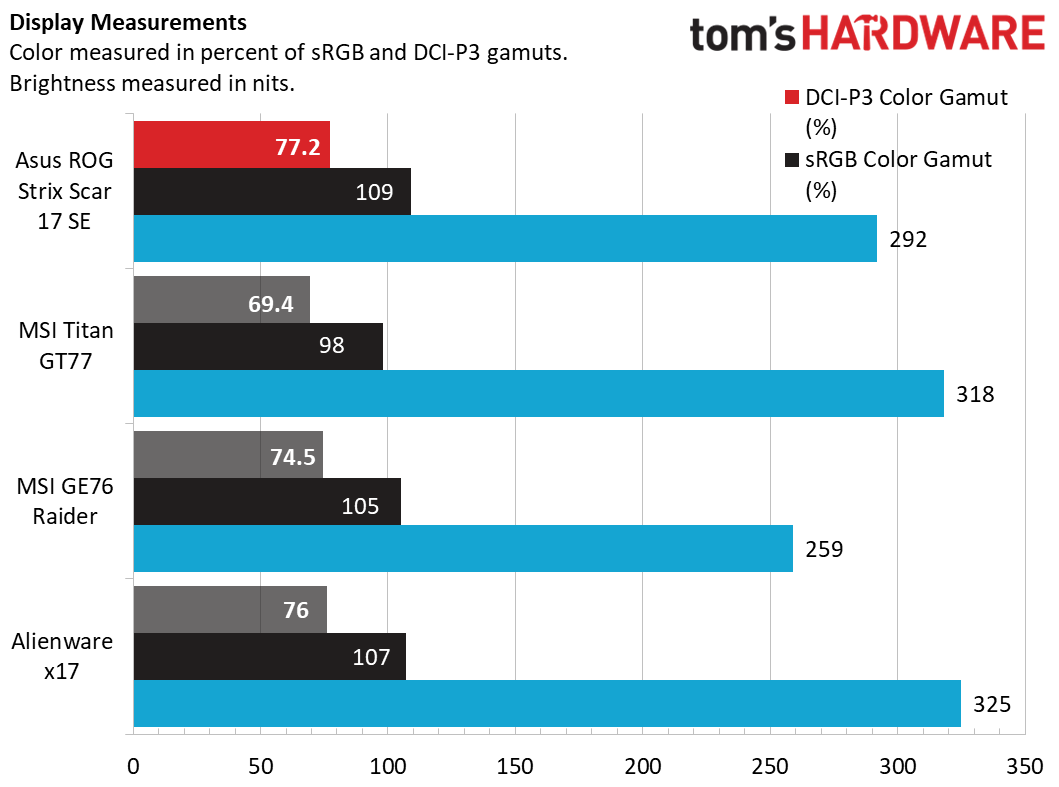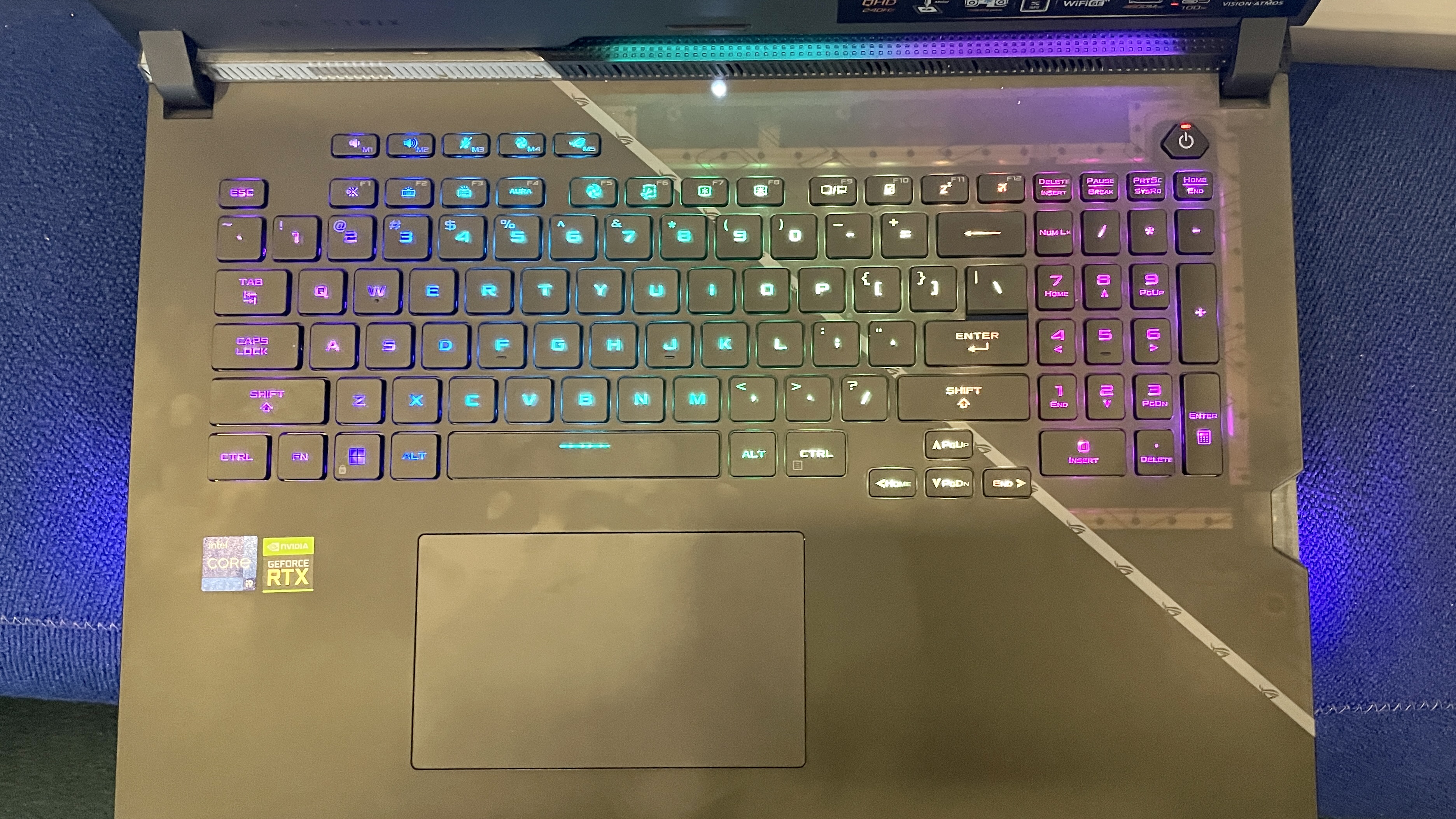Tom's Hardware Verdict
The Asus ROG Strix Scar 17 SE has a fantastic CPU/GPU combo married to a practical build at a phenomenal starting price.
Pros
- +
Strong components
- +
Functional build
- +
Many ports to choose from
- +
Stays cool to the touch
Cons
- -
No webcam
Why you can trust Tom's Hardware
So many brands are focused on making laptops look pretty rather than offering substance behind the design. Asus’ ROG Strix Scar series goes for a utilitarian approach with rubber grips and soft-touch surfaces that give its design purpose, even if the G733Z model we reviewed not so long ago lacked high-end performance. But the Asus ROG Strix Scar 17 Special Edition we’re looking at here has both a pretty package and power to back up its looks.
Equipped with an Intel Core i9-12950HX and an Nvidia GeForce RTX 3080 Ti, our Strix Scar 17 SE configuration can handle any game or activity you throw at it. It also has a fantastic 17.3-inch 1440p display with Dolby Vision capabilities, all for $3,499.
While it lacks a webcam, making it less functional as a work-from-home PC and it was tough to find in stock when we wrote this, the Asus ROG Strix Scar 17 SE is a strong contender for one of the best gaming laptops. But a few rivals take the Strix Scar to task in terms of performance.
Design of the Asus ROG Strix Scar 17 SE (G733)
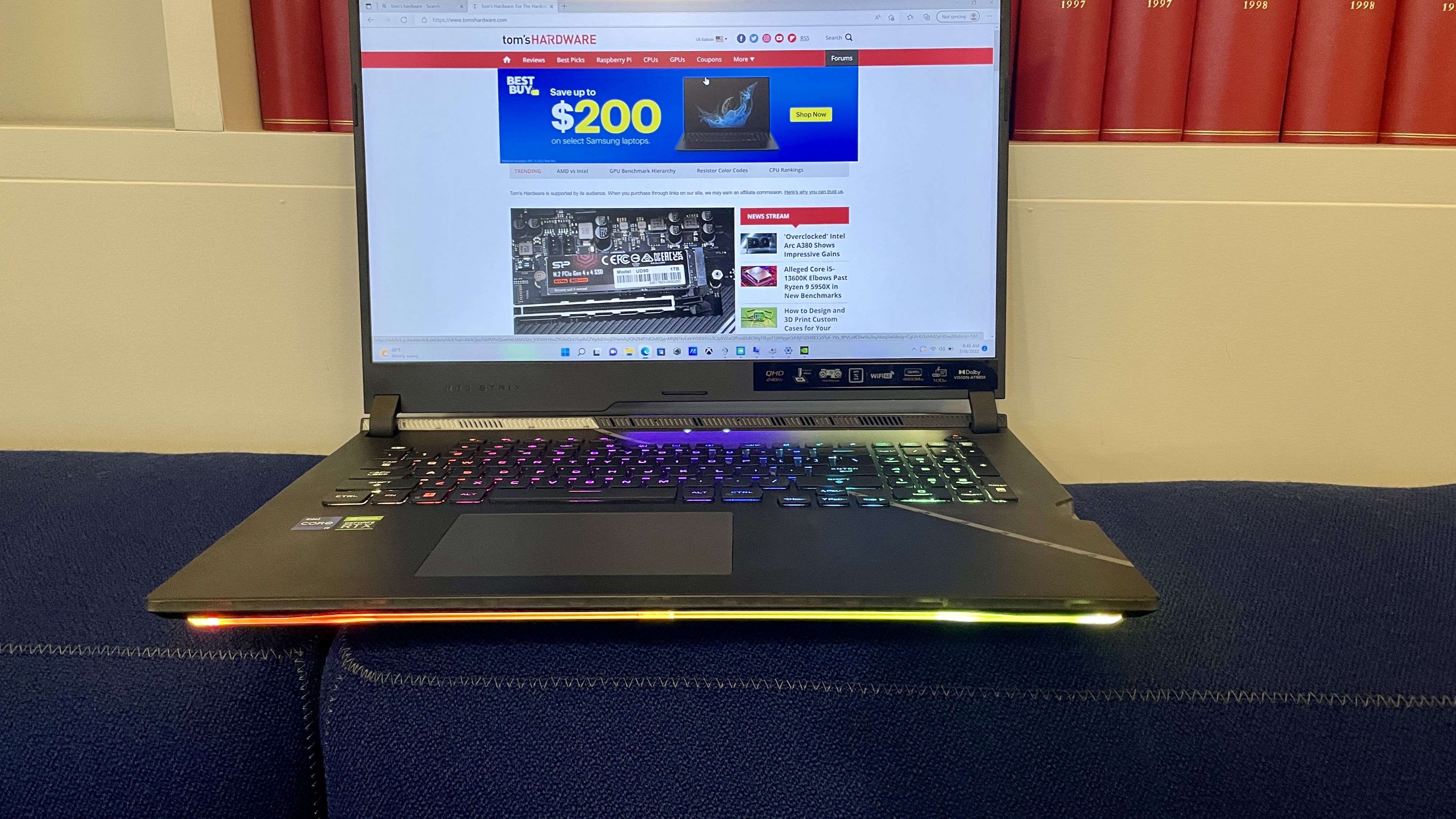
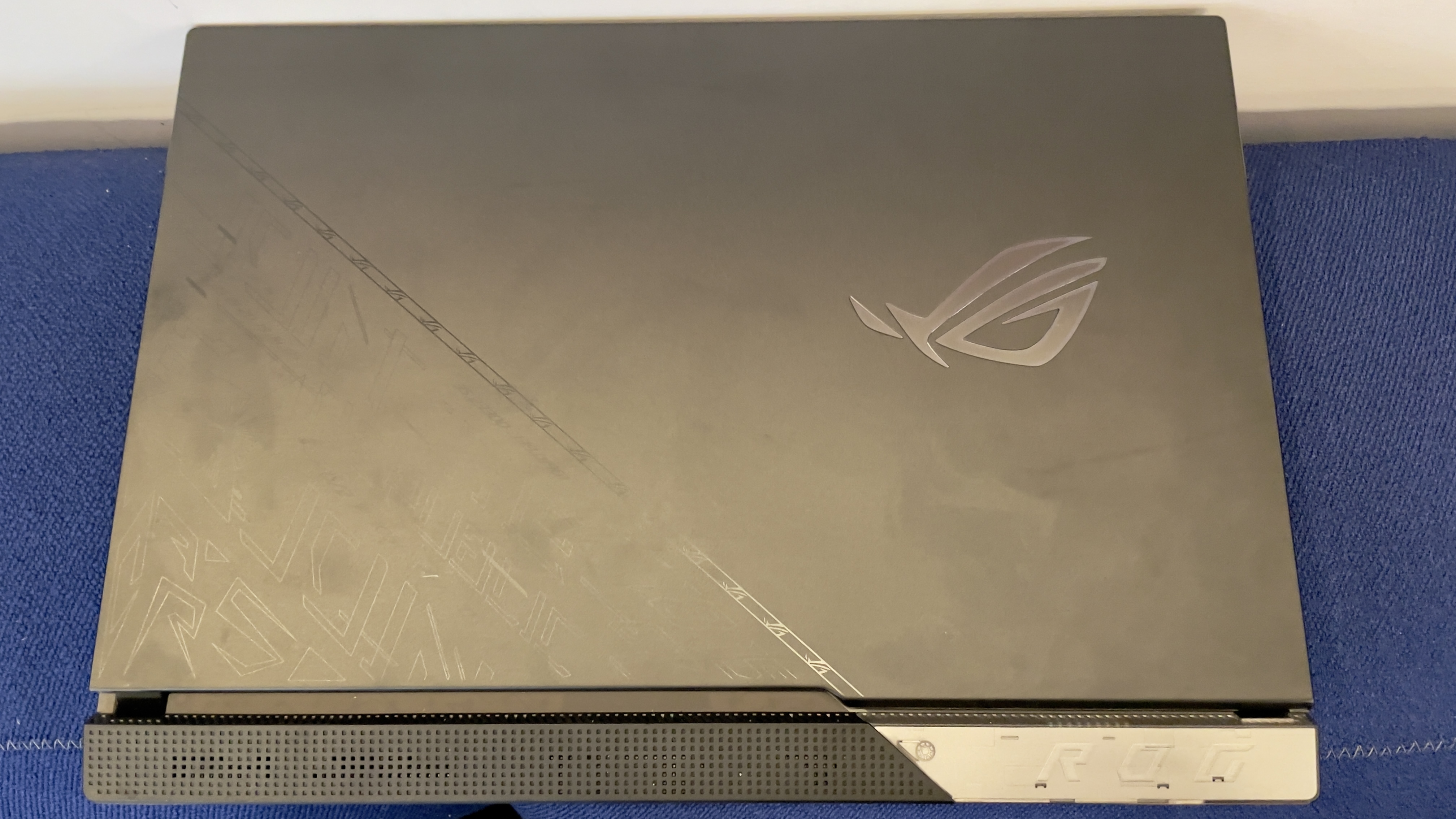
The Asus ROG Strix Scar 17 SE is a chunky black and silver laptop that utilizes several materials across all its surfaces, including a thick rubberized grip underneath to keep it in place while typing and easier to hold. There’s RGB lighting within the ROG logo on the lid and a subtle gray strip with the same symbol. On the bottom left, there’s a printed design that’s hard to make out when it’s not under direct lighting, but glows in multiple colors when lit with a UV flashlight that the laptop ships with.
Asus utilizes customizable “armor caps” for the ROG Strix Scar, an accessory that slides onto the back of the laptop with a small magnetic force to hide its hinges. Armor caps come in silver and two shades of black, and Asus allows people to 3D print their own with a template provided on its website.
The back ports, which is where most of the laptop’s connections are housed, live between vents on either side.

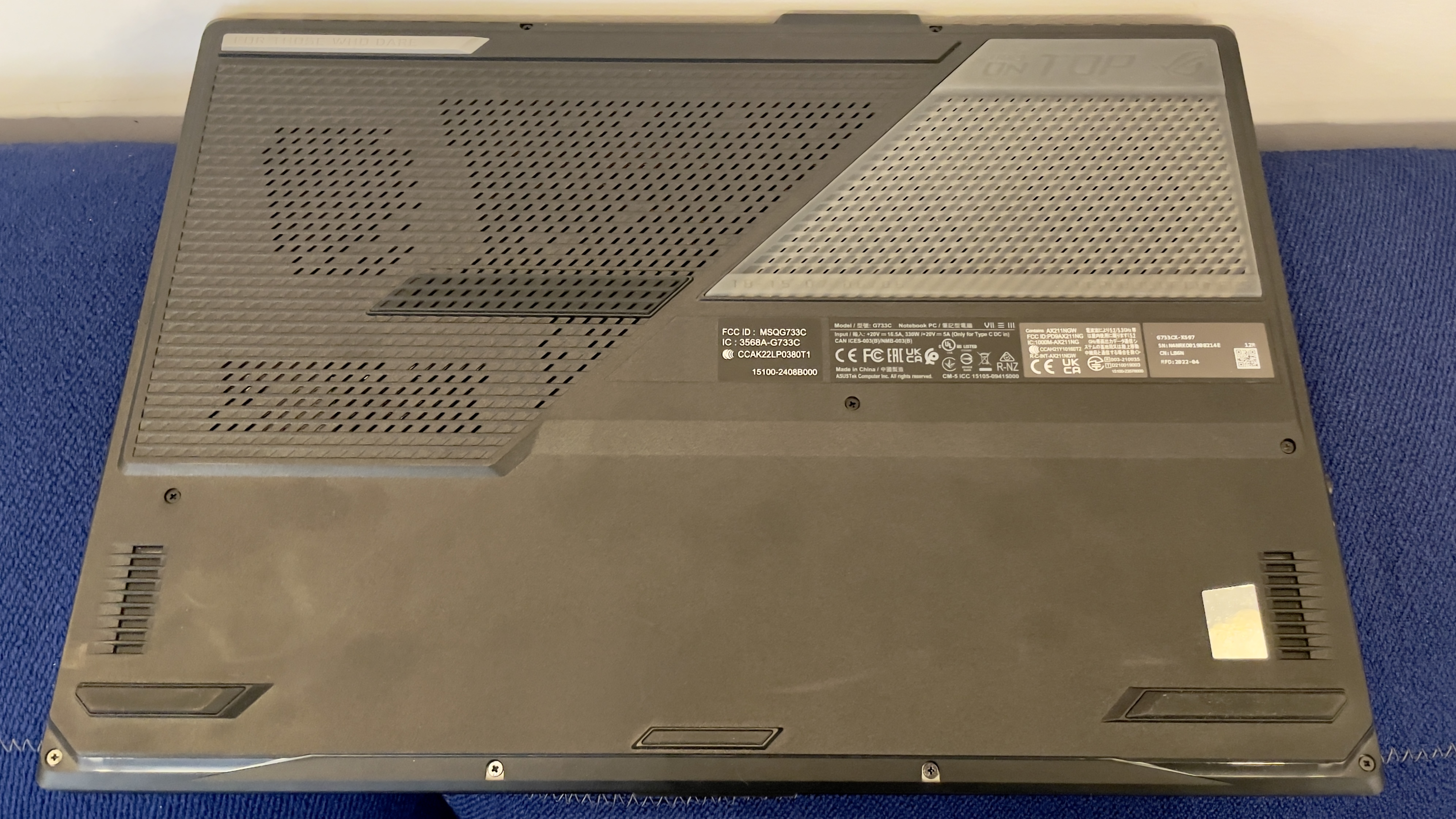
The rear holds a Thunderbolt 4 port, a USB-C 3.2 port, an HDMI 2.1 port, an Ethernet jack, and a port for the power adapter. On the left side of the Asus ROG Strix Scar is another vent, followed by two USB-A ports and a 3.5 mm headphone jack. The right has space for an Asus keystone to import lighting and sound settings from different machines (or house different settings for other users).
Get Tom's Hardware's best news and in-depth reviews, straight to your inbox.
Surrounding the outer edges of the front-underside is wraparound RGB lighting, which looks fantastic in tandem with the strip of RGB lighting underneath the bottom of the display, in a gap between the screen and the laptop’s base.
When you open the Strix Scar SE, there’s a small notch to lift the lid, but it doesn’t house a webcam. There’s no excuse for a big expensive laptop not to have a webcam, especially after the events of the last few years. Now, if you have the money to afford this rig, you can probably spring for one of the best external webcams. But if you want to use it with the camera on the go, that means carrying around another dedicated device.

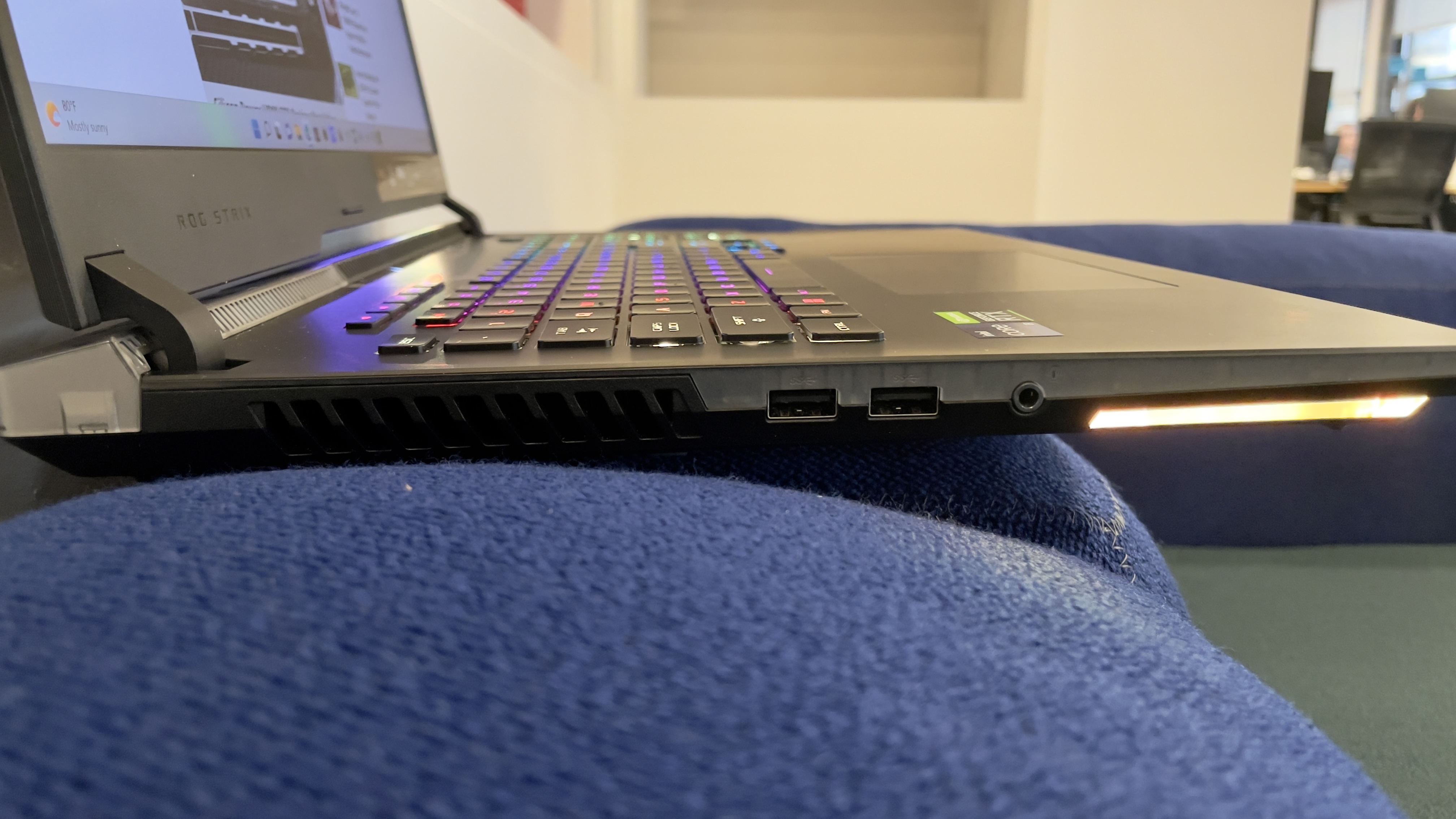

The right half of the laptop’s surface is strikingly made of semi-translucent plastic, showcasing some of the internals, while a strip with the ROG logo runs diagonally across the deck, dissecting the translucent portion from the more traditional design of the left side of the laptop. The left 2/3 of the deck utilizes a matte black soft-touch plastic over the rest of the plastic deck to help keep the surface cool to the touch while gaming.
I like how much practicality is behind the Strix Scar’s design. Its matte surface material keeps its surface cool, and a rubber grip on the bottom keeps it steady on your desk and makes it easier to carry, and the added flair of the armor caps hides the hinges. Static blacks and different-looking surfaces are not things you’d usually find on more glossy, premier laptops like Alienware x17, which uses aluminum and magnesium in its build.
Measuring 15.55 x 11.10 x 0.92 inches and weighing 6.1 pounds, the Scar 17 SE is the lightest 17-incher amongst competitors. The MSI Titan GT77 is 15.63 x 12.99 x 0.91 inches and 7.28 pounds, the MSI GE76 Raider’s dimensions are 15.6 x 11.2 x 1.01 inches at 6.39 pounds, and the Alienware x17 R2’s are 15.7 x 11.8 x 0.8 inches at 6.5 pounds.
Asus ROG Strix Scar 17 SE (G733) Specifications
| CPU | Intel Core i9-12950HX |
| Graphics | Nvidia GeForce RTX 3080 Ti (16GB GDDR6) 1,590 MHz Boost Clock,170W Max Graphics Power |
| Memory | 32GB DDR5-4800 |
| Storage | 2TB PCIe Gen 4 SSD |
| Display | 17.3-inch 2560 x 1440, 240Hz QHD IPS |
| Networking | Intel Wi-Fi 6E AX211 (802.11ax) 160Mhz, Bluetooth 5.2 |
| Ports | Thunderbolt 4, USB 3.2 Gen 2 Type-C, 2x USB 3.2 Gen 1 Type-A, HDMI 2.1, 3.5 mm headphone jack, 2.5 GB Ethernet port, Keystone |
| Camera | None |
| Battery | 90 WHr |
| Power Adapter | 330W |
| Operating System | Windows 11 Pro |
| Dimensions (WxDxH) | 15.55 x 11.10 x 0.92 inches (394.97 x 281.94 x 23.36 mm) |
| Weight | 6.39 pounds (2.9 kg) |
| Price (as configured) | $3,499.99 (as configured) |
Gaming and Graphics on the Asus ROG Strix Scar 17 SE (G733)
Our ROG Strix Scar 17 SE configuration had an Intel Core i9-12950HX alongside an Nvidia GeForce RTX 3080 Ti with 16GB of GDDR6 memory. The GPU has a 1,590 MHz boost clock and 170W max graphics power. Those specs ensure stellar frame rates at 1080p and its native 2560 x 1440 resolution.
When I played Control with both the quality preset and Ray Tracing on high at the Strix Scar’s native 1440p resolution, the game ran at a smooth 70 frames per second (fps) without DLSS enabled. When I turned it on, the laptop’s frame rate jumped up to 87 fps.

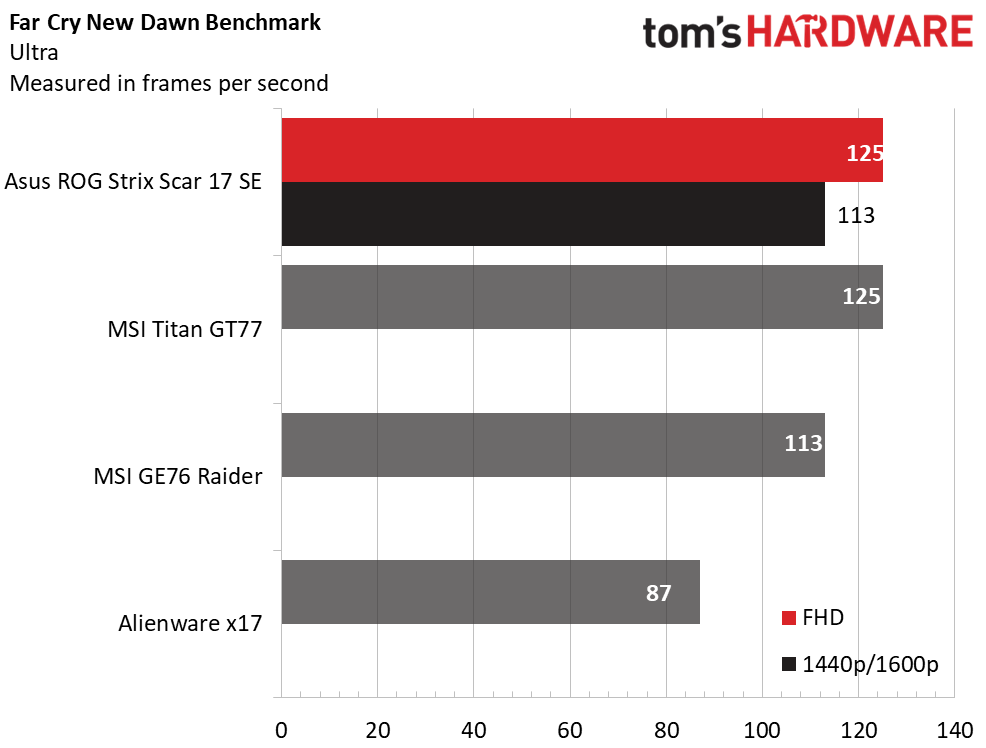



When we ran Grand Theft Auto V’s benchmark at very high settings, the ROG Strix Scar 17 SE managed 144 fps at 1080p and 91 fps in its native 1440 resolution. Although its rival laptops sport the same RTX 3080 Ti as the Strix Scar 17, it had the most impressive numbers. At 1080p, the MSI Titan GT77 played at 142 fps, the GE76 Raider hit 139 fps, and the Alienware x17 R2 delivered 129 fps.
During the Far Cry New Dawn (ultra settings) test, the ROG Strix Scar 17 SE reached 125 fps at 1080p and 113 fps at 1440p. The Titan GT77 performed the same 1080p, followed by the GE76 Raider at 113 fps and the Alienware x17 R2 at 87 fps.
On the Red Dead Redemption 2 benchmark (medium settings), we saw the ROG Strix Scar 17 SE output 85 frames per second at 1080p and 61 fps at 1440p. The Titan GT77 has effectively tied with the Strix Scar again, with the GE76 Raider just a few frames behind. The Alienware x17 R2 secured fourth place once again with 78 fps.
When we ran the Shadow of the Tomb Raider benchmark (highest settings), the ROG Strix Scar 17 SE hit 119 fps at 1080p and 83 fps at its native resolution. The Titan GT77, surprise, surprise, was only a couple of frames behind at 117 fps, with the GE76 Raider not too far off and the Alienware in last place.
Lastly, on the Borderlands 3 benchmark (badass settings), the Strix Scar scored 109 fps at 1080p and 79 fps at 1440p. The Titan GT77 and GE76 Raider were tied, and the Alienware x17 R2 came in last with 97 fps.
To measure gaming laptops’ performance over time, we run the Metro Exodus benchmark on RTX settings 15 times, simulating about half an hour of gameplay. The game ran at 81.43 frames per second and stayed pretty consistent throughout the benchmark.
During the stress test, CPU speeds came in at an average of 3.0 GHz on the performance cores and 2.4 GHz on the efficiency cores, while the CPU temperature averaged 79.6 degrees Celsius (175.28 degrees Fahrenheit). The GPU ran at an average of 1,341.38 MHz and a temperature of 74.5 degrees Celsius (165.38 degrees Fahrenheit).
Productivity Performance of the Asus ROG Strix Scar 17 SE (G733)
We tested the ROG Strix Scar 17 SE with an Intel Core i9-12950HX CPU, 32GB of DDR5 RAM, and 2TB of SSD storage. With its 5-GHz boost clock, 8 performance cores, and 8 efficiency cores, the Core i9-12950HX allowed Asus’s laptop to deliver strong results in productivity benchmarks. However, competitors are equipped with comparable components.
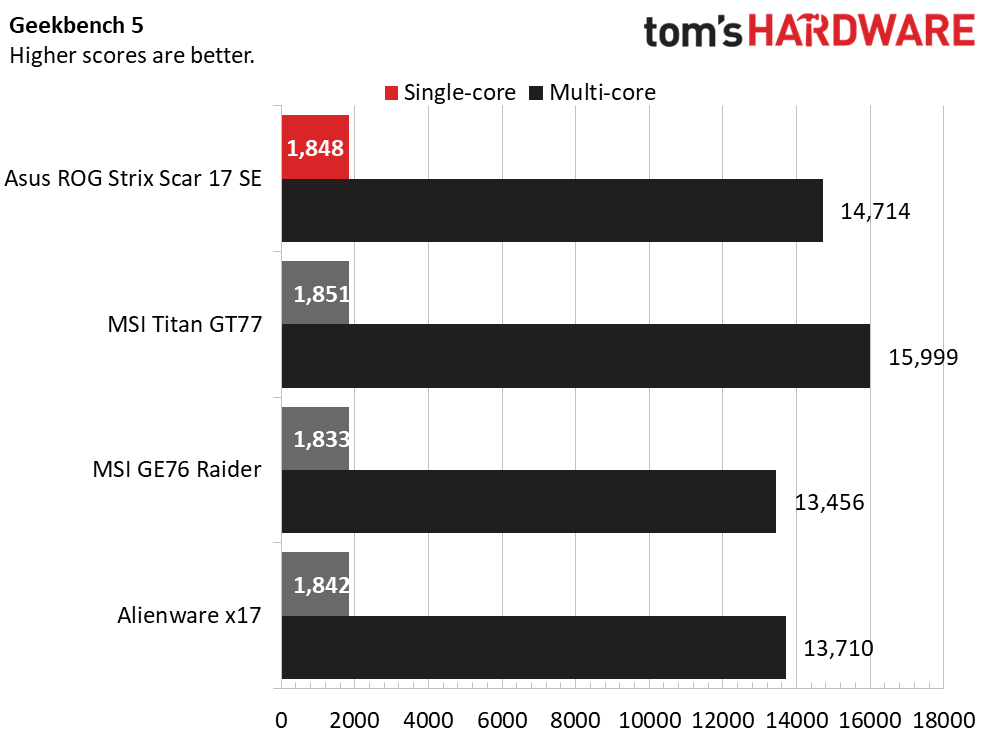
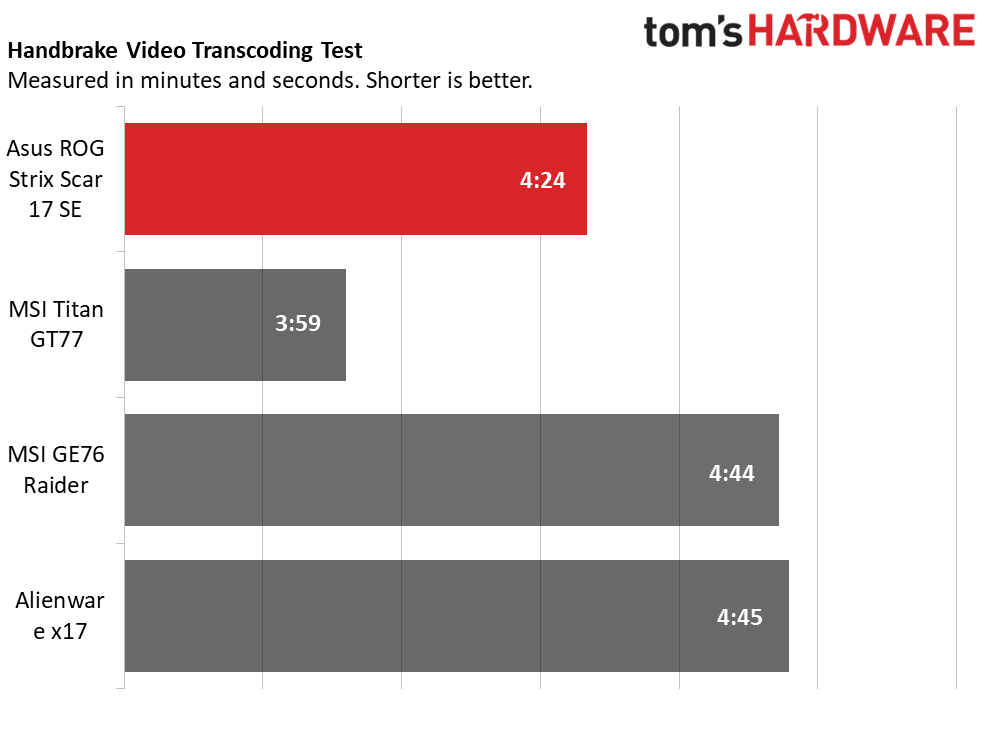
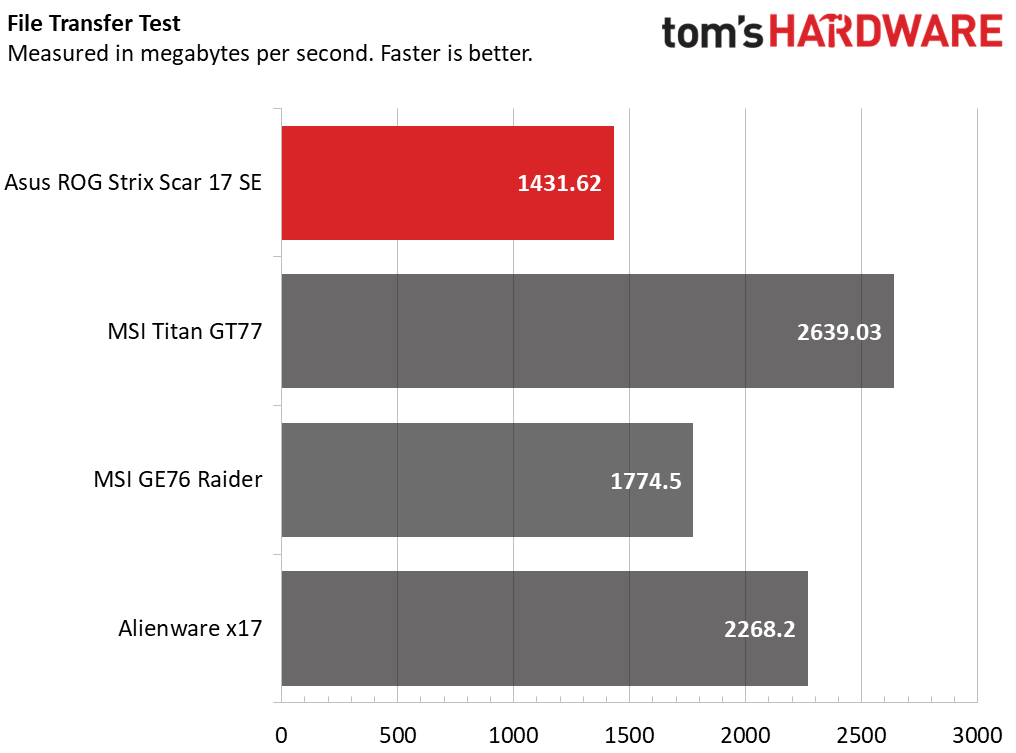
On Geekbench 5.4, an overall performance test focused on the CPU, the ROG Strix Scar 17 SE earned a single-core score of 1,848 and a multi-core score of 14,714. Meanwhile, the MSI Titan GT77 with an i9-12900HX reached a single-core performance score of 1,851 and a multi-core score of 15,999. The MSI GE76 Raider (i9-12900HK) hit 1,833 single-core, and 13,456 multi-core scores. Finally, the Alienware x17 R2 and its i9-12900H processor achieved a 1,842 single-core score and a 13,710 multi-core score.
When we tested video transcoding with our Handbrake test, the ROG Strix Scar 17 SE was the second fastest to convert a 4K video to 1080p, at 4 minutes and 24 seconds. Ahead of it was the MSI Titan GT77 at 3:59. Meanwhile, the GE76 Raider and Alienware x17 R2 brought up the rear at 4:44 and 4:45, respectively, effectively tying.
The ROG Strix Scar 17 SE copied our 25GB of test files at an average speed of 1,431.62 MBps. The MSI Titan blew past the competition with a 2.639.03 MBps average speed, the Alienware x17 R2 trailed behind with 2,268.20 MBps, and the GE76 Raider lagged at 1,774.5 MBps.
Display on the Asus ROG Strix Scar 17 SE (G733)
Our configuration of the Asus ROG Strix Scar 17 SE featured a 17.3-inch display with a 240 Hz refresh rate, 2560 x 1440 resolution.
When I watched the latest season of Stranger Things, I noticed how sharp the picture was and how great the low-key lighting looked on my display just before Hop got into one of his many prison brawls this season. Anytime the show cut to something red, it looked striking, whether its the blood from the brawl or the red from the Upside Down.
Games looked fantastic on the Strix Scar 17 SE’s display, especially in Control, where the ray tracing during Jesse’s introduction to Emily Pope really stood out. I kept noticing reflections bouncing off of the shelter vaults and the light rays hitting Jesse’s leather coat. I could also observe small details, like dust floating around the light beams. The picture always remained sharp, vibrant, and displayed darkness alongside contrasting lights very well.
In our testing, the Asus ROG Strix Scar 17 SE’s panel covers 77.2% of the DCI-P3 color gamut and 109% of the sRGB color gamut. The competing MSI Titan GT77 covered 69.4% of the DCI-P3 color gamut and 98% of the sRGB color gamut in our tests. The MSI GE76 and Alienware x17 R2 had comparable panels covering roughly the same amount of each color gamut. However, the Alienware x17 R2 had the brightest display, reaching 325 nits. Behind it was the Titan GT77 with 318 nits, followed by the Strix Scar at 292 nits. Only the MSI GE76’s display was dimmer, at 259 nits.
Keyboard and Touchpad on the Asus ROG Strix Scar 17 SE (G733)
The keyboard for the Asus ROG Strix Scar 17 SE felt responsive during my keystrokes, but on liftoff, I could feel how mushy the switches were after each keystroke. But when I got to the end of my time with a machine, I was used to the feeling, and it stopped being distracting. When I tested my typing ability on 10fastfingers, I scored 60 words per minute with a 98.03% accuracy rating, which is around the ballpark of what I usually score on gaming keyboards.
The 5.1 x 3.1-inch touchpad offers a solid user experience. The surface feels nice, and the borders are distinctive. I had no issues clicking or performing various Windows 11 gestures.
Audio on the Asus ROG Strix Scar 17 SE (G733)
The two speakers underneath the ROG Strix Scar 17 SE deliver detailed, pulsating kicks. When I listened to “2 of Amerikaz Most Wanted '' by 2Pac and Snoop Dogg, the track had great vocal clarity and treble, as I could hear the song’s subtle ambient effects throughout. But I wish I were able to turn the volume up louder.
I opened the preloaded Dolby Access app to try out the Warm, Balanced, and Detailed presets under its music settings. Warm increased bass, Balanced evened out the sounds, and Detailed turned up the treble, but nothing affected the volume. I enhanced the audio on the Windows 11 sound settings but couldn’t hear any difference. And the RealTek Audio Console app offered no real help in tweaking the sound.
Dolby Atmos works best while watching content, and the movie settings preset bolstered the bass, vocal clarity, and detailed noises from the Stranger Things episode I was watching. I found the balanced preset to be the best when watching content, as it offered the strongest overall sound quality without any compromises.
Upgradeability on the Asus ROG Strix Scar 17 SE (G733)
To get to the Strix Scar’s internals, I used a Phillips head screwdriver to remove eleven screws from the bottom cover and a pry tool to unlatch the panel fully. Take precautions when removing the panel because there are two cables for the LED lights attached to it and the motherboard. The vapor cooling chamber sits beside the dual fans, showcasing the laptop components with a funky bronze design. The two filled RAM slots, under the black sheets here, can be upgraded to 64GB. In our unit, the two SSD slots were also already filled with a pair of M.2 drives in RAID 0.
Battery Life on the Asus ROG Strix Scar 17 SE (G733)
On our battery test, which involves streaming video, browsing the web, and running OpenGL tests over Wi-Fi with the display at 150 nits of brightness, the ROG Strix Scar ran for 5 hours and 44 minutes. It was the second longest to hang in there next to the MSI Titan GT77 at 6:05. The MSI GE76 Raider wasn’t too far behind at 4:57, and the Alienware x17 R2 died after just under 3 hours. Although nearly 6 hours of battery life is fine enough for a gaming laptop, the size and weight of the power adapter reminded me of the brick that knocked out Marv in Home Alone 2. So keep that in mind in terms of the Strix Scar’s mobility.
Heat on the Asus ROG Strix Scar 17 SE (G733)
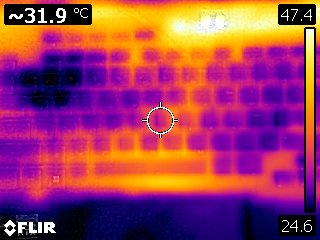
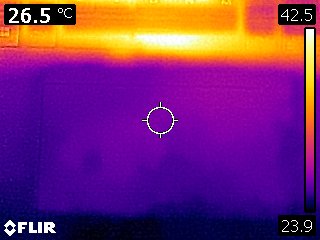

I checked to see how hot-to-the-touch the Asus ROG Strix Scar 17 SE gets while running our Metro Exodus stress test. At the center of the keyboard, between the G and H keys, the laptop hit 31.9 degrees Celsius (89.42 degrees Fahrenheit). However, the surrounding deck felt much cooler. The touchpad remained cool at 26.5 degrees Celsius (79.7 degrees Fahrenheit.)
However, the bottom of the laptop was the hottest spot at 57.8 degrees Celsius (136.04 degrees Fahrenheit), and HWInfo reported some CPU thermal throttling throughout the test.
Software and Warranty on the Asus ROG Strix Scar 17 SE (G733)
The preloaded software on the Asus ROG Strix Scar 17 SE is surprisingly light. Armoury Crate displays real-time stats of your CPU/GPU, memory and storage consumption, fan speed, and device temperature.
Aura Creator allows you to change the RGB lighting over the Strix Scar and the keyboard's backlighting.
MyAsus is a hub that will enable users to run diagnostics, customize the keyboard backlight, choose power & performance settings, access AI-noise cancellation features, and more.
Dolby Access allows you to set up Dolby Vision and Atmos for pristine visual/audio and choose sound presets best for your setup
Asus sells the Asus ROG Strix Scar 17 SE with a one-year limited warranty.
Asus ROG Strix Scar 17 SE (G733) Configurations
We tested a $3,499.99 configuration Asus ROG Strix Scar 17 SE (G733CX-XS98), outfitted with an Intel Core i9-12950HX, an Nvidia GeForce RTX 3080 Ti, 32GB of RAM, a 2TB SSD, and a QHD (2560 x 1440) display with a 240 Hz refresh rate. Oddly, this laptop has another configuration on Asus’ website (model G733CX-XS97) with 16GB of RAM that lists for the same price. So if you see both in stock somewhere, obviously opt for the model with twice the RAM if the prices are indeed the same.
Bottom Line
The Asus ROG Strix Scar 17 SE is a phenomenal laptop in a near-perfect package. The design keeps gamers in mind at every step and is more concerned with offering functionality than looking like a pretty accessory. But it also has excellent RGB placement and subtle accents that make it attractive. The attractive chassis is paired with a powerful CPU/GPU combo and an impressive 17-inch Dolby Vision-enabled display capable of making any content look fantastic at 1440p.
Competitors kept up with the Strix Scar’s performance in gaming and productivity. But even the most impressive of the rivals, the MSI Titan GT77, with its slightly superior performance and display, costs $4,000 as configured versus the ROG Strix Scar 17 SE’s $3,499 price as we reviewed it. The main problem with the Strix Scar 17 is availability. As we wrote this, it was sold out on Asus’ site and didn’t seem to be available elsewhere, although B&H has it up for preorder. If you’re in no hurry to acquire excellence, look out for the Asus ROG Strix Scar 17 SE when it comes back in stock.

Isaac Rouse is a staff writer at Tom's Hardware. He reviews laptops and various gaming peripherals.
-
Sleepy_Hollowed Wow, this is truly an amazing bang for the buck, and to be honest, the no camera option is perfect for a lot of places where they need laptops like that, or just people that'd rather not have it for privacy.Reply
This is on the top two on my list of windows laptops.
